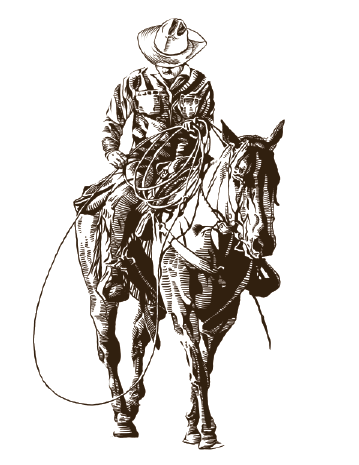Y4. Lesson 15. Practise triple metre
Prior learning: None
Duration: 30 minutes
Materials: Woodblocks or claves
Keywords: Beat, rhythm, singing, chanting, partners, rhymes, circle games.
Difficulty: ![]()
Prepare
modern music genres
Present
Practise
triple metre
 Melodic development
Melodic development
![]() Students add a new song to their repertoire in triple metre and discover a slur.
Students add a new song to their repertoire in triple metre and discover a slur.
- Lead the class in singing the song.
- Ask the pattern of strong and weak beats [strong-weak-weak]
- Ask the metre of the song [triple]
- The word 'Montan' is sung over two separate notes joined together by a slur.
- A slur is a curved line that connects two or more notes of different pitches. A slur means the notes should be played smoothly, with no space in between.
- This is an old cowboy song. Ask who is Ol' Paint [a horse]
- What is the rider going to do? [leave Cheyenne and ride to Montan']

 Rhythmic development
Rhythmic development
![]() Students discover more about the dotted minim.
Students discover more about the dotted minim.
- Teach that the dotted minim lasts for three beats with the rhythm name called too-m.
- Ask students to repeat the too-m sound and write the dotted minim in their notebooks.
- Remind students that a crotchet (ta) lasts for one beat, and a minim (too) lasts for two beats.
 Creative movement
Creative movement
![]() Students move creatively to different music genres.
Students move creatively to different music genres.
- Play the first track on the player.
- Students should dance to the beat, being as creative as possible.
- When finished, ask if anyone knows the song and its name.
- Ask students if they liked or disliked the music and why.
- Repeat the process of dancing, naming and opinions of the music with the other tracks, ranging from heavy metal to pop to R&B.
 Listening
Listening
![]() Students listen to known songs and say the metre.
Students listen to known songs and say the metre.
- Students will listen to the first track on the player.
- Ask the name of the song [Bee Bee]
- Ask the metre of the song [duple metre]
- Play the song again and ask students to conduct in duple metre. Demonstrate if the class is unsure.
- Repeat with the second song [Snail Snail, duple metre]
- The third and fourth songs are in triple metre. Students should conduct in triple metre. Demonstrate if the class is unsure [refer to the diagram in partwork below]
- The fifth and sixth songs are in quadruple metre and students conduct accordingly. Demonstrate if the class is unsure.
 Visual learning
Visual learning
![]() Students discover where bar lines should be placed in triple metre.
Students discover where bar lines should be placed in triple metre.
- Project or print out the worksheet. If printed, students must draw in the bar lines.
- Tell students that they are musical detectives and, because someone forgot to fill them in, must discover where the missing bar lines are.
- There will be two barlines for each example.
- Students should add the beats on each staff to make a count of three, as the exercise is in triple metre.
- Remind students of the values of a minim, dotted crotchet, crochet and quaver and which combinations add up to three.
- Ask a volunteer to come forward and show the class where the first bar line should be drawn.
- Another volunteer should show where the second bar line should be drawn.
- The process continues until the last example is finished, and the exercise begins again with other students.
 Instruments
Instruments
![]() Students
Students
 Part work
Part work
![]() Students discover how to conduct in triple metre.
Students discover how to conduct in triple metre.
- Conducting in three metre involves a three-beat pattern.
- Teach students how to conduct Cuckoo in triple metre in the following fashion:
- Downbeat (Beat 1): Start by moving your hand or baton downward in a straight line. This is the strongest beat and represents the first beat of the measure.
- Second Beat: Move your hand to the right (for the conductor) or inward if you conduct without a baton. This beat is slightly lighter than the first.
- Third Beat: Move your hand back up in a curved motion, creating a loop. This is the lightest beat of the three.
- The pattern resembles a triangle or a lowercase "j" shape. The downbeat is always the strongest, and the third beat is the lightest, which helps give triple time its characteristic flowing feel.
 Assess
Assess
Suggested lessons
Y1. Beat II

Y1. Beat III

Y1. Beat IV

